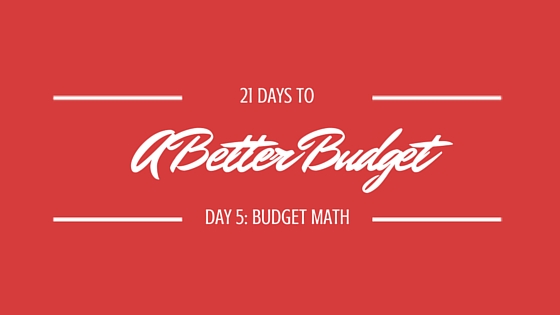
Over the past three days, you have been working really hard at laying the foundation for your budget. You have started to track your expenses (some of you were already tracking – which is so awesome), tallied up your income, and identified your top three money goals. I am really proud of you!
Now it’s time to start putting these pieces together into the big picture. The big picture that I like to call YOUR BUDGET.
The basic premise of creating a balanced budget (otherwise known as a zero-based budget) is shockingly simple. You don’t even need to have taken 6th grade math to be able to handle the computation.
It’s just X – Y = 0 (<— that’s a zero, not the letter O).
But wait, you may be thinking, that’s not a solvable equation since I don’t know the value of the variables. Well, good news – you do know them. Or at least you will soon!
X represents your total income in a month.
Y represents your total outflow in a month – i.e. all of your spending and saving.
So when X – Y = $0, you’re in balance.
What if Y (outflow) is greater than X (income)? Then your total will be a negative number. This is known as running a deficit, which we will be talking about in greater detail in a couple of days.
And finally, if X (income) is greater than Y (outflow), your total will be positive, which means you have a surplus. This may sound like a fun “problem” to have, but I think it’s actually a sign that you haven’t yet been intentional enough about your budgeting. Stay tuned for more on that as well.
Budget Math is really as simple as it gets. In fact, you probably knew all of this already – it’s hardly rocket science. But sometimes there is knowing things… and then there’s KNOWING them. Numbers are neutral – it’s how we feel about them and act upon them that can get us into trouble.
Tomorrow we are going to start moving from tracking to budgeting, from theory (and mathematical equations) to reality. Are you ready?
Don’t miss a post! Click Here to Subscribe to the FREE 21 Days to a Better Budget Newsletter















Hi Mara! Been reading for a long time, and years ago you inspired my husband and me to read Dave Ramsey too. So, the concept of a zero balance budget is not new to us, but we are terrible about actually doing it. (In general, we have these inspiring conversations about money and then are terrible about carrying it out for the long haul.) My husband feels that at the end of each month, we should have a buffer in our checking account, so that it’s not actually going down to zero, and we’ve got that extra money sitting there just in case. I get that, but I also am frustrated by the “just in case” – because if we were budgeting every penny, then we shouldn’t need “just in case” money, right? (We do have a separate emergency fund, but it’s small.) Are we missing a concept here? Is there a compromise? My husband is very good at math, so I think the big picture is easier for him to see, while I am terrible at math and like the idea of allocating every last dollar. Thanks!
A lot of people like that cushion and technically there’s nothing wrong with it. But it just isn’t being fully intentional with allocating your resources. Probably your husband wants it there because you guys aren’t tracking regularly and therefore have months when you “go over”. This cushion helps to absorb any of that. Maybe you guys can work on getting a bit more focused on tracking throughout the month – so you know where things stand and can make adjustments as need be. Tracking may help you to realize that you’re going over on one or two specific categories, which means you really need to increase those budgets. Once that happens, your husband will probably feel more comfortable reducing (or eliminating) that cushion. I hope that helps!
Thanks! Yes to the tracking… it’s probably the groceries…or the growing toddler…